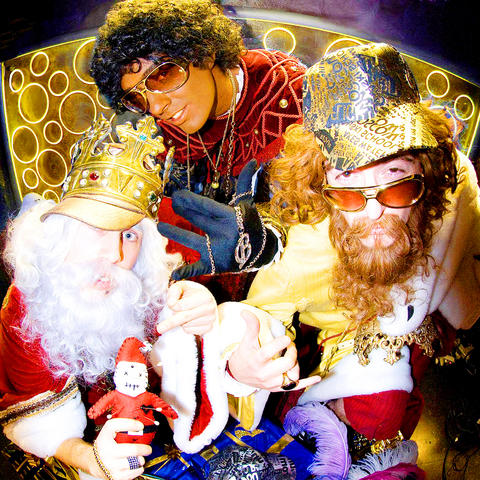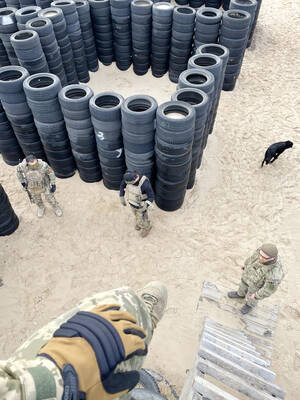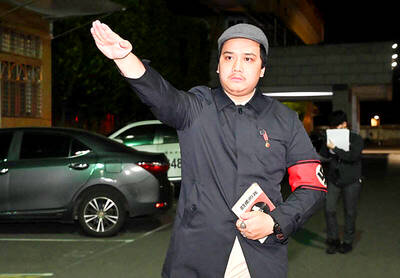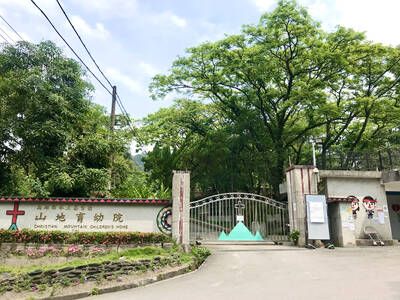No Spanish child would question that presents are an inseparable part of Christmas, but who should bring them, the Three Kings or Father Christmas?
The Spanish tradition of the Three Kings (Reyes Magos, literally “king-magicians”) is increasingly being challenged by the Anglo-Saxon and northern European Father Christmas.
Many Spaniards consider Father Christmas a commercial US invention, but he has an advantage over the Three Kings in that his earlier timetable allows children to enjoy their presents over the Christmas holidays.

PHOTOS: DPA
Traditionally, Spaniards give Christmas presents on Jan. 6 after watching glittering processions of the Three Kings the previous evening.
Black Baltasar, white-bearded Melchor and red-haired Gaspar represent kings and astrologers who are believed to have come to pay their respects to the new-born Jesus, bringing him gifts.
Naughty children, however, are only given a black sweet called coal, according to the Spanish tradition.
The camel-riding kings have been part of the Spanish Christmas for centuries, and it is only in the 1950s that US soldiers stationed in Spain began popularizing Father Christmas, Papa Noel in Spanish.
The figure also known as Santa Claus is believed to be based on that of the 4th-century bishop Nicholas and on northern European folk traditions.
The white-bearded old man dressed in red rides across the sky in a sledge pulled by reindeer in a snowy landscape, something that hardly fits in with Spain's warmer climate.
The increasing popularity of Father Christmas has been accompanied by another import, the Christmas tree.
The real or more often plastic fir tree now competes with the traditional Spanish Nativity scenes comprising miniature statues showing the baby Jesus surrounded by Mary, Joseph, shepherds, kings and other Biblical characters.
Spain's Catholic Church initially criticized Father Christmas and the Christmas tree as Protestant intrusions.
Today, Spaniards no longer look down on Father Christmas for religious reasons, but as “an invention of Coca-Cola,” because of his use in advertising campaigns.
Father Christmas does, however, have an undeniable advantage over the Three Kings. He comes on Christmas Eve, Dec. 24, leaving children more time to enjoy their presents before school begins.
People dressed as Father Christmas can now be seen distributing leaflets on streets and in shopping centers, and many Spaniards hang Papa Noel dolls from their windows as a Christmas decoration, often alongside dolls representing the Three Kings.
“The kings are an example of multiracialism, while Father Christmas is a product of consumerism,” one participant wrote in an Internet discussion on the advantages and disadvantages of both traditions.
“Both are a part of the Christian tradition,” another countered.
“The magic of the kings is deep in my heart,” one commentator wrote, and the kings are now fighting back. A Madrid advertising agency launched an anti-Father Christmas campaign, with a Web site showing a Papa Noel voodoo doll “to give him what he deserves.”
“Who the hell are you?” three rapping kings wearing sunglasses and fancy hats sing to Father Christmas on a video clip, accusing him of “exploiting elves” at his gift factory. “You think you are riding high and your pyjamas were designed by Coca-Cola,” the song goes.
Most Spanish families, however, ignore the controversy. Nearly 60 percent of them gave presents only on Jan. 6, according to a poll done in the late 1990s, but Father Christmas has gained ground since then.
“The families of most my friends give gifts on both days,” a 15-year-old girl says.

Even by the standards of Ukraine’s International Legion, which comprises volunteers from over 55 countries, Han has an unusual backstory. Born in Taichung, he grew up in Costa Rica — then one of Taiwan’s diplomatic allies — where a relative worked for the embassy. After attending an American international high school in San Jose, Costa Rica’s capital, Han — who prefers to use only his given name for OPSEC (operations security) reasons — moved to the US in his teens. He attended Penn State University before returning to Taiwan to work in the semiconductor industry in Kaohsiung, where he

On May 2, Chinese Nationalist Party (KMT) Chairman Eric Chu (朱立倫), at a meeting in support of Taipei city councilors at party headquarters, compared President William Lai (賴清德) to Hitler. Chu claimed that unlike any other democracy worldwide in history, no other leader was rooting out opposing parties like Lai and the Democratic Progressive Party (DPP). That his statements are wildly inaccurate was not the point. It was a rallying cry, not a history lesson. This was intentional to provoke the international diplomatic community into a response, which was promptly provided. Both the German and Israeli offices issued statements on Facebook

May 18 to May 24 Pastor Yang Hsu’s (楊煦) congregation was shocked upon seeing the land he chose to build his orphanage. It was surrounded by mountains on three sides, and the only way to access it was to cross a river by foot. The soil was poor due to runoff, and large rocks strewn across the plot prevented much from growing. In addition, there was no running water or electricity. But it was all Yang could afford. He and his Indigenous Atayal wife Lin Feng-ying (林鳳英) had already been caring for 24 orphans in their home, and they were in

Australia’s ABC last week published a piece on the recall campaign. The article emphasized the divisions in Taiwanese society and blamed the recall for worsening them. It quotes a supporter of the Taiwan People’s Party (TPP) as saying “I’m 43 years old, born and raised here, and I’ve never seen the country this divided in my entire life.” Apparently, as an adult, she slept through the post-election violence in 2000 and 2004 by the Chinese Nationalist Party (KMT), the veiled coup threats by the military when Chen Shui-bian (陳水扁) became president, the 2006 Red Shirt protests against him ginned up by